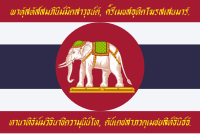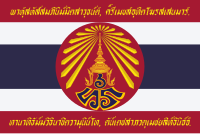Siamese Expeditionary Force
| Siamese Expeditionary Forces | |
|---|---|

The Siamese Expeditionary Force in Paris Victory Parade, 1919.
|
|
| Active | 1917–19 |
| Disbanded | 1919, after the signing of the Treaty of Versailles |
| Country | Kingdom of Siam |
| Allegiance | Triple Entente |
| Role | Combined arms |
| Size | 1,233 men |
| Engagements | |
| Decorations |
|
| Commanders | |
| Notable commanders |
|
| Insignia | |
| Flag (obverse) |  |
| Flag (reverse) |  |
The Siamese Expeditionary Force consisted of the Royal Siamese Army sent to Europe under the command of Major-General in 1917 to help fight World War I.
Siam’s decision to declare war was a shrewd political move, but there were precedents from other non-European small states. The decision to send an expeditionary force to Europe, however, was radical. It was designed to demonstrate both Siam’s modernity and civilization to the West and the seriousness with which King Rama VI and elite viewed the need to uphold the principles of international law and morality. It was further designed to strengthen Siam’s claim to equal treatment in a post-war settlement.
The decision likely evolved from a suggestion by the French government that a volunteer ambulance unit be set up by Siamese students in Europe. French diplomats further suggested that Siam could provide automobile drivers to assist in supplying the troops and aviators, who could be trained at French flying schools as pilots and mechanics.
Siam’s army in 1917 was not particularly well-equipped or well-trained for participation in the slaughter of World War I. It possessed little modern equipment or artillery and had no experience of operating in Europe or in a climate or terrain other than its own. It did, however, possess officers trained in modern warfare and military strategy and, importantly, it had a modern flying squadron. No other arm of the military was considered as modern as the air force. The king and his senior diplomats and military officers gladly picked up on the French suggestion.
That the army of a sovereign East Asian nation should fight in Europe was unprecedented and electrifying for the elite and large parts of the general population in Bangkok. Opposition to the decision to become actively involved in the war was limited. Some opponents were politically motivated, as was true of the pro-German members of the elite; opposition also came from religious groups who argued more fundamentally against the involvement of Buddhists in war.
Opposition notwithstanding, the minister of war issued a call for volunteers in September 1917 to form a contingent to display the Siamese National Flag in Europe. He spelled out three objectives: to actively aid the Allies; to gain active military experience; and to uphold national dignity, honor and glory. The assembled expeditionary force consisted of a 414-men-strong aviation corps of pilots and aircraft mechanics and an 870-men-strong motor corps of automobile drivers, mechanics, medical and support staff.
...
Wikipedia
